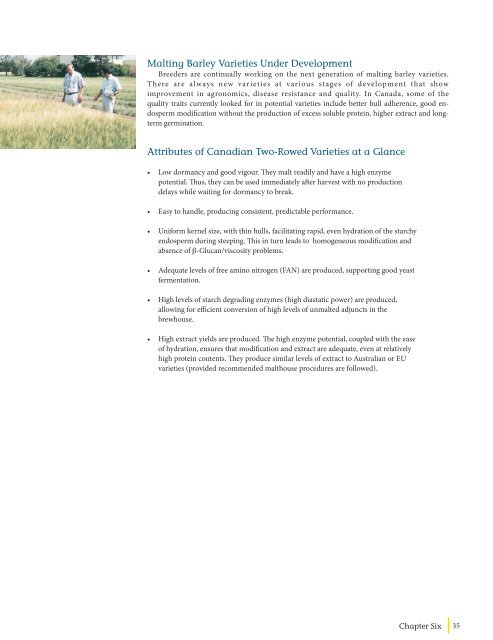MALTING QUALITY TRAITS - Canadian Malting Barley Technical ...
MALTING QUALITY TRAITS - Canadian Malting Barley Technical ...
MALTING QUALITY TRAITS - Canadian Malting Barley Technical ...
You also want an ePaper? Increase the reach of your titles
YUMPU automatically turns print PDFs into web optimized ePapers that Google loves.
<strong>Malting</strong> <strong>Barley</strong> Varieties Under Development<br />
Breeders are continually working on the next generation of malting barley varieties.<br />
There are always new varieties at various stages of development that show<br />
improvement in agronomics, disease resistance and quality. In Canada, some of the<br />
quality traits currently looked for in potential varieties include better hull adherence, good endosperm<br />
modification without the production of excess soluble protein, higher extract and longterm<br />
germination.<br />
Attributes of <strong>Canadian</strong> Two-Rowed Varieties at a Glance<br />
• Low dormancy and good vigour. They malt readily and have a high enzyme<br />
potential. Thus, they can be used immediately after harvest with no production<br />
delays while waiting for dormancy to break.<br />
• Easy to handle, producing consistent, predictable performance.<br />
• Uniform kernel size, with thin hulls, facilitating rapid, even hydration of the starchy<br />
endosperm during steeping. This in turn leads to homogeneous modification and<br />
absence of b-Glucan/viscosity problems.<br />
• Adequate levels of free amino nitrogen (FAN) are produced, supporting good yeast<br />
fermentation.<br />
• High levels of starch degrading enzymes (high diastatic power) are produced,<br />
allowing for efficient conversion of high levels of unmalted adjuncts in the<br />
brewhouse.<br />
• High extract yields are produced. The high enzyme potential, coupled with the ease<br />
of hydration, ensures that modification and extract are adequate, even at relatively<br />
high protein contents. They produce similar levels of extract to Australian or EU<br />
varieties (provided recommended malthouse procedures are followed).<br />
Chapter Six<br />
35


